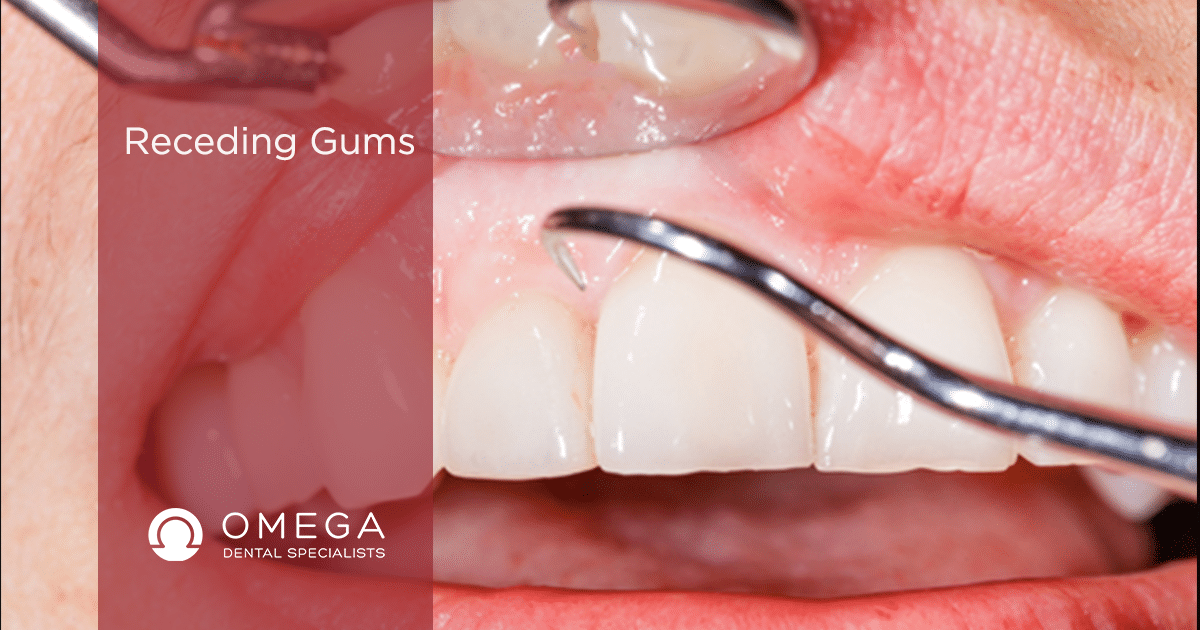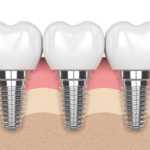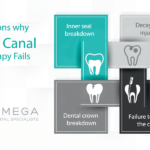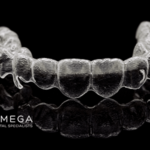Receding Gums

Table of Contents
What are Receding Gums or Gingival Recession?
Receding gums are defined as the exposure of the roots of the teeth due to receding gum line. In other words, gingival recession is gum lines that are pushed back away from your teeth. If you have experienced receding gums, you may notice that your teeth appear longer than they really are. You will notice this when you smile or while brushing your teeth. Is this a problem? Receding gums can be brought about by a number of reasons but in general, it is not much of a matter to be worried about unless your gums are not healthy. Checking the health of your gums is the job of a periodontist. Therefore, it is so important to bring issues, like this, to your dentist to be sure. If your gums are not healthy and your gums are receding this is a problem that should be brought up. This is something that can be cured and even treated under the care of a trusted periodontist.
Receding Gums That Are Unhealthy:
If your gums are not healthy and your dentist confirms that your gums are receding, you are at risk for gum disease. Gum disease is caused by inflammation or swelling of the gums that damage the jawbone. Gum disease can have three stages that range from mild to severe. The three stages are gingivitis, periodontitis, and advanced periodontitis. Gingivitis is the start of the three stages and its main symptom includes receding gums which show the roots of the teeth. How do you know if you are passed the gingivitis stage? You are passed the gingivitis stage if you experience inflammation, soreness, swollen, red, tender, or bleeding gums. You should also check for signs of loose teeth and visible pus around the teeth. The first stage, just as the rest o the stages, are painless and can go undetected if dental hygiene is not practiced. The fact that the gingivitis step is painless is a sign that stages two and three can sneak up on you and become advanced rather quick. It is important to pay attention to your teeth and gums. If you spot any changes to your teeth and gums keep an eye on these changes and if it escalates even a little bit bring it up to a dentist.
The Causes of Gum Recession:
There can be multiple causes that make the gums recede. The causes can range from something minor that you can’t control dental hygiene habits. Let’s start with the minor cause: genetics. Genetics are apart of our DNA as well as your teeth and gums. They even play a role in illnesses and traits that get passed along to us from our parents. Of course, there is a 50-50 chance we will inherit these traits but who knew teeth could be one of them?
To be more specific, you may have inherited receding gums if this issue runs in your family. If you don’t have this problem now, stay on the lookout. The way that you brush and floss can impact gum health. If you find that you brush your teeth too hard this may be a reason for receding gums. To make matters better, use a soft-bristled toothbrush and remember to be gentle on your teeth and gums. The way that your teeth are positioned can cause gum recession too. Crooked teeth or teeth that are not aligned have a higher risk of developing receding gums. Are you grinding your teeth when you sleep? Grinding your teeth whether you are awake or not can cause more dental problems than gum recession alone. To make this problem less problematic, ask your dentist about the possible usage of mouthguards.
Have you been injured? Injuries cause dental problems and trouble with gums. The problem here is related to ‘trauma’ to gums. This is one of the causes of receding gums that you can’t control. Receding gums are not your fault, but you still need to address the issue and get treatment as soon as possible. Never let anything dental injuries go untreated. Discuss this matter with a dentist. One of the most common causes of gum recession is poor oral health. Not taking care of your teeth and gums is quite common so don’t be shy about going to a dentist for treatment and help. Its never too late to start taking care of your teeth.
What are the dental treatment options for receding gums?
Gum recession is not an issue that happens overnight. It builds up with time. Receding gums can occur over a period of years. A couple of signs of gum recession are sore gums and sensitive teeth. Sometimes sensitive teeth can be mildly painful to severely painful. The pain shouldn’t be ignored even if you think it is only temporary. Other signs include teeth appearing longer and spaces between teeth appearing bigger at the base. Let’s say you brought the issue up to your dentist; what are your treatment options?
-
Dental Deep Cleaning and Cost of Deep Cleaning
Typically, when you go to the periodontist, a hygienist will clean your teeth and remove plaque and tartar at the gumline. A deep dental cleaning is also known as scaling and root planing. This is where a dentist will clean both the surface of your teeth and the roots inside of it, focusing on both tartar and plaque. That’s the scaling part. The root planing involves fixing the root and making it smoother so that your gums can reconnect with your teeth. Teeth deep cleaning will not reverse your receding gums – there’s nothing that can be done to do that, but it will help prevent possible future gum disease from forming in the area where the gums used to be. This may be a multi-visit process depending on the extent of work that is needed. You will likely need a local anesthetic and there is the minimal risk that the work might damage the outside of the tooth. Antibiotics may be needed to prevent post-procedure infection.
Cost of teeth deep cleaning is usually covered by your dental insurance. Without dental insurance, dental deep cleanings typically cost between $150 to $800 (per quadrant).
-
Gum Grafting and cost of gingival grafting
This procedure, also known as a gingival graft, is necessary if your gum recession has taken a bad turn – like a root has become exposed. Your periodontist will take tissue from another part of your mouth and graft it to the affected area. Once the graft has healed, the tooth root will likely be protected and you’ll look like you have healthier gums. There are three types of gum grafts: Connective tissue, free gingival, and pedicle grafts. The connective one is where the dentist will open a flap in the roof of your mouth, take some tissue, graft it to the affected area and then close the flap. Free gingival is where the dentist takes it right from the top of the mouth, no flap, and stitch it to the affected area. If you have a lot of gum tissue in the affected area, then the dentist may opt for a pedicle, or lateral, graft. In that case, he or she will cut only part of the gum and stitch it to the affected area. Post-surgery, you will likely get pain medicine, antibiotics, and instructions on recovery. It should take about 1-2 weeks to recover.
When you have gum grafts, your insurance usually covers all the expenses. Without dental insurance, gum graft costs between $400 to $1200 per procedure.
-
Gum Tissue Regeneration:
Regeneration is a procedure for those who have an advanced case of receding gums that involve damaged bones. This procedure will be conducted by a periodontist who will use a substance material and place it an area where the missing bone is to restore the bone and tissue this regenerating it. The gum tissue is secured in the area where the teeth are involved.
How to Prevent Gum Recession?
Watch out for signs of gum recession and be aware of your gum health. The key to treating this problem is to catch it in its early stages. There are many preventative care measures that you can take such as utilizing fluorides, desensitizing paste, and more. To address the issue of receding gums it is a good idea to visit Omega Dental Specialist and let our the top of the line dentists take care of you.





